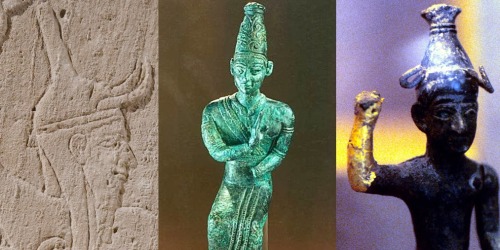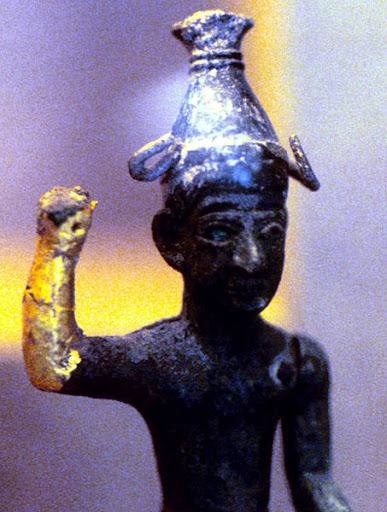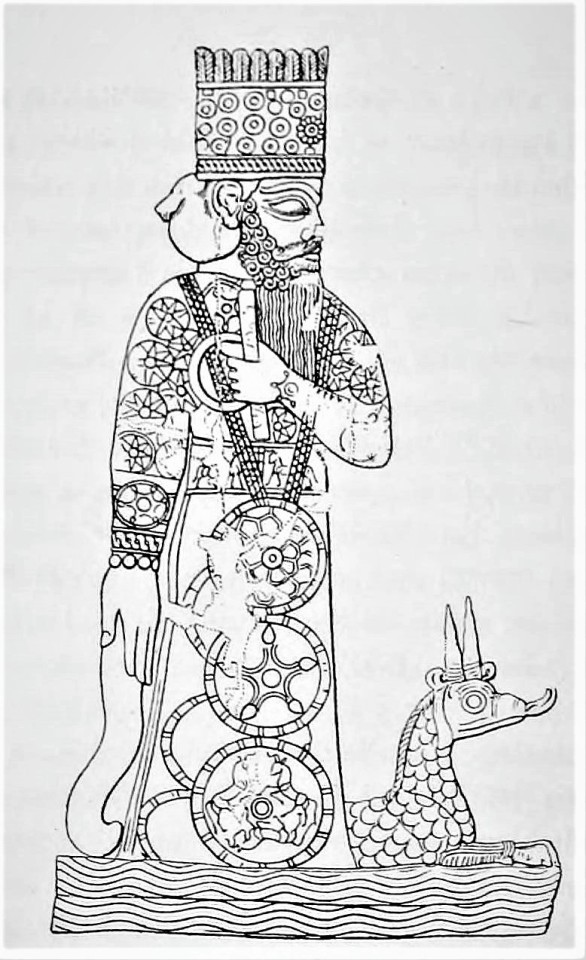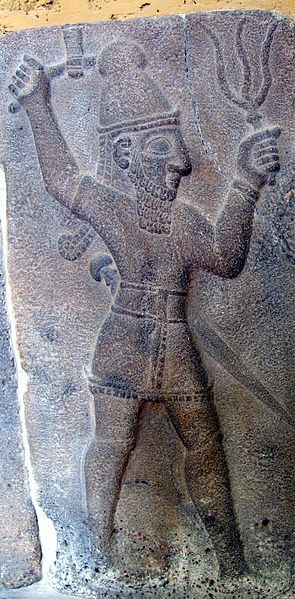
WLW, esteemed history enthusiast, pseudohistory debunker, haniwa purveyor, biggest Ninshubur fan not counting Rim-Sin of Larsa
Catching Elephant is a theme by Andy Taylor
Who is Baal, anyway?

As I mentioned in my previous article, the instigator of the recent attacks on museums in Berlin believes some of the artifacts held in them to be part of a nefarious, bloodthirsty cult, prominent on the “global satanism scene” and devoted to “Baal (Satan),” as he put it himself according to articles covering this incident. In the following article I’ll discuss the origin of this esoteric claim, as well as the actual nature of Baal, myths associated with him, other similar deities and their role in the ancient Middle East (and beyond).
I’ll start with the
matters I am not particularly enthusiastic about: Baal is the star of
many conspiracy theories, mostly these which arise in christian
fundamentalist circles, and which cast him as the deity venerated by
nefarious groups, ranging from insufficiently conservative political
parties and ethnic minorities to vampiric aliens, blamed for all of
the world’s evils.
He owes this status to being one of the
most frequently mentioned “false gods” or “idols” in the
Bible. In fringe pseudohistory context it’s basically a given that
Baal is equated with the nebulous figure of Moloch, the child
sacrifice boogeyman. They are not actually analogous, though - Baal
is brought up in relation to idol worship, depicted as powerless, and
generally associated with people from coastal cities like Sidon and
Tyre – the groups Greeks collectively called „Phoenicians.”
Moloch meanwhile is associated with the Ammonites, whose
kingdom lied further inland – it is possible that he is therefore a
biblical corruption of the Ammonite god Milkom. Some researchers
propose instead that “Moloch” was a type of sacrifice involving
the burning of victims in honor of a deity – this theory matches
both the accounts of biblical Moloch, as well as some Greek and
especially Roman accounts meant to prove the debased, barbaric nature
of Phoenicians, especially these from Carthage.
In later
writing, all of the idols and false gods mentioned in the Bible were
equated with the devil - in reality their inclusion in biblical text
likely reflects struggle between various faiths and their cult
centers in ancient Canaan, and later increasingly more fragmentary
memories of it. In Christian demonology and in occultism, in addition
to their names being considered synonyms of the devil, new demonic
identities were assigned to them, which is where the popculture idea
of Beelzebub, Bael and other similarly named figures has its origin.
As almost every type of pseudohistory eventually connects to
blood libel (or an equivalent of it), the exaggerated assumptions
about biblical Moloch inspired Gilbert K. Chesteron to propose that
blood libel was based on real events, specifically on possible
outbreaks of “idolatry” in Jewish communities leading to bloody
sacrifices. Needless to say, this is an outlandish, baseless claim
rooted in prejudice.
The scarce textual sources left behind
by the Phoenicians themselves do not discuss any rites which match
biblical and roman claims particularly commonly – occasional
mentions paint an image similar to the sacrifice of Iphigenia in
Greek myth, which would imply that human sacrifice was either the
domain of myth, or a rarely performed act which only occurred as an
irrational response in times of great peril. Romans claimed the
epicenter of such practices was Carthage, their early rival to the
title of the preeminent power of the Mediterranean, and its recipient
was its tutelary god, Baal Hammon – a figure not directly relate to
the biblical Baal(s), who I will discuss later, but for centuries
commonly assumed to be one and the same as him due to the lack of
primary sources.
Excavations from Carthage do show the
existence of funerary sites with a high concentration of child
burials, but it’s a matter of heated scholarly debate if they
represent a proof of Roman propaganda being rooted in truth, or if
it’s simply the result of the well known fact that infant mortality
prior to modern times was widespread. The debate is ongoing and I do not
follow it closely.
There is however precisely zero evidence of
human sacrifice being performed in Ugarit, the most significant site
associated with the most famous, and arguably original, Baal. The
extensive cult literature recovered from its ruins discusses the
sacrifice of cattle, sheep, rams, birds (but only uncommonly),
donkeys (only for a specific reconciliation rite), oil, wine, and
precious stones and metals - but not humans (researchers also often
point out that dogs and pigs were never offered to gods too, which is
a pretty clear proof that some taboos present in abrahamic faiths
predate them).
The Ugaritic texts do mention that sacrificial
meat was at least sometimes shared by the devotees (in the case of
sacrifices which did not involve a pyre, obviously – which
essentially means such sacrifices were feasts or holiday meals
ritually shared with the deity), which I assume where the false idea
that both Phoenicians of classical antiquity and their bronze age
Canaanite forerunners were cannibals might come from.
This
specific claim seems to be currently spreading as “trivia”
online, alongside a false etymology of the word cannibal (a term only
attested since the beginning of Spanish colonization of the
Americas). It should be noted that even the researchers who do
believe that human sacrifice might have sometimes occurred in
Carthage do not suggest that it was followed by cannibal feasts, and
even in Roman propaganda texts from the Punic wars period no such
claims show up, despite their obvious bias and need to demonize the
recently vanquished rival nascent power.

In art of ancient Levant,
worshipers are sometimes depicted as tiny compared to gods – many
“scandalous” conspiracy posts claim as a result that the
minuscule figures raising their hands on ancient artifacts represent
infants sacrifices to the gods depicted. However, accompanying
inscriptions identify them as kings or priests – this is the case,
for example, with the famous Baal stele from Ugarit, depicting a king
praying to the tutelary god of the city.
With the unpleasant
matters out of the way, it’s time to finally ask - who is Baal?
Baal refers both to a specific figure, and to the general
concept of a head god of a city’s pantheon in certain parts of the
Levant and Mesopotamia. “Baal” simply means “lord” and can be
found in both titles and names of not only gods, but also royals –
including some biblical examples.

As I said, the Baal most famous today is Baal Hadad of Ugarit, a city in present day Syria which was among the victims of bronze age collapse. This Baal was derived from an earlier god, Adad, who seemingly first became a major figure near present day Aleppo, emerging as the head of the local variation of Syro-Hurro-Mesopotamian pantheon. Eventually, the title of Baal started to be regarded as his true name, with Hadad relegated to the rank of a title. His other titles include “Rider of Clouds” and “Aliyan” (“Victorious”). His cult survived the destruction of Ugarit, and flourished well into Ptolemaic times.

In Ugarit, he served not
only as a god of rain and thunder, but also agriculture and
fertility, and, as expected from the lead god, a source of royal
power. He was depicted as an impulsive and boastful figure in myths, but was
also a firm ally of humans, subduing monsters, the forces of nature,
and even promising to protect his followers from wrath of other gods
in myths. His symbolic animal was the bull, and he was usually
depicted in horned headwear. The associations between bull horns and
divinity is well attested in the religious art of Mesopotamia,
Anatolia and Levant, and to a degree Egypt too. Bulls are prominently
featured in the art of Minoan Crete as well. This is also why the
biblical golden calf is, well, a calf.
Baal Hadad’s family
tree is rather confusing, with two separate gods being called his
fathers in the Baal Cycle and other texts. The interpretation can
potentially be complicated by the fact that Ugarit’s (and other bronze age kingdoms’) kings seemingly
often called monarchs they viewed as more powerful as „fathers”
and these of similar perceived prestige as „brothers” in
diplomatic correspondence. For example, one can operate undeer the assumption the god Dagon was Baal’s actual father (he’s
only ever brought up in such a context, and shared many of Baal’s
roles, and like him was a prominent god deeper inland as well) while
El, the elderly king of the gods, was only Baal’s „father” in the
diplomatic sense of the term. Some scholars instead propose that
Dagon and El were partially or fully syncretised in Ugarit, that mention of Dagan was a nod to foreign tradition, or even
that Baal having two fathers might be the echo of the myth of Baal’s
Hittite counterpart.
Our main source of information about Baal
is the Baal cycle, a heroic epic recovered from Ugarit in the 1920s
and a subject of much scholarly analysis ever since. While not
perfectly preserved, it is nonetheless a very valuable source of
information, and arguably it’s what allowed Baal to metaphorically
speak in his own voice to modern researchers. It details his struggle
with various enemies seeking to ruin his dream of becoming the king
of the gods.
While it’s hard to tell if that was the intent
of the ancient writers, Baal appears as somewhat of an underdog in
this myth – his posdible father doesn’t seem to be a god of particular
importance, he has to rely on his allies to accomplish most of his
heroic deeds, he whines about having no house of his own, and his
actions are often impulsie. However, this shouldn’t overshadow the fact he was for the most part the most popular god of Ugarit.
Figures associated with the
Ugaritic Baal include:
- Anat - a war goddess who shares Baal’s impulsive nature, and in myths frequently acts as his main ally or enforcer, slaying various sea monsters and the personification of death, Mot (however, there are a few instances showing Baal siding with humans rather than with Anat). She’s often referred to as Baal’s sister, and sometimes argued to also be his consort, though this view is challenged nowadays by some researchers. It should be noted that while Baal is firmly established as Dagon’s son, Anat is never presented as related to the latter – she is pretty firmly only a daughter of El and, implicitly, his wife Asherah.
- Ashtart - the Ugaritic forerunner of the famous Phoenician Astarte. She was equated with Babylonian Ishtar, and while she’s not as prominent as Anat in Ugaritic texts, they emphasize her roles as a warrior and hunter; she is however also renowned for her beauty. In the Baal Cycle she berates Baal for his insufficient determination during the battle with his first opponent, and later announces his victory to the world. In many texts, both in Ugarit and beyond, her epithet is “face of Baal,” implying a particularly close bond between these two figures – it is plausible that she was viewed as Baal’s consort in Ugarit. Ashtart/Astarte is NOT the same figure as Asherah (technically Athirat), the Canaanite mother goddess, and both of them appear in the Baal cycle in different roles.
- Kothar-wa-Khasis – a craftsman god, indirectly equated with and possibly in part derived from Egyptian Ptah – myths state outright that he lives in Memphis, where Ptah’s main temple was located. He acts as a reliable ally to Baal, providing him with weapons and precious objects and eventually also building his palace. In one scene, an argument occurs between him and Baal over whether the palace needs windows:

- Yam – the god of the sea, also serving as Baal’s rival to the throne. Various passage of the myth and other texts portray him as violent, tyrannical and otherwise unpleasant, and his overthrow by Baal as a positive development. He’s aided by a number of sea monsters, the most notable of which is the serpent Lotan. It has been argued that that the later Babylonian Tiamat was in part based on him or his counterparts, as she doesn’t appear in any Babylonian sources earlier than Enuma Elish, which is a work younger by a few centuries than the Baal cycle.
- Mot – a personification of death and desolation. While even Yam received some reverence and offerings, Mot did not – he only existed as an antagonist for heroic figures. Mot’s main trait is his insatiable hunger.
While the Baal from Ugarit is, due to
possessing his own heroic epic, the most famous and probably best
researched today, he was by no means the only deity of this sort –
most cities in the Levant (and beyond, in other areas settled by the
Phoenicians) had their own tutelary gods, often referred to as Baals.
Among these, notable
examples include:
- The Baal of Tyre – Melqart served as the lead deity of the city of Tyre, seemingly the most prominent of the Phoenician centers. His name seems to simply mean “lord of the city”. He was a god of many things, most notably being viewed as a culture hero who discovered the secret of producing the purple dye which made Phoenician city-states rich and prosperous. He was also an underworld deity, and as a result an association with Babylonian Nergal has been proposed. It’s quite likely that the Tyrian Baal was the one mentioned in some Biblical accounts – for example, Jezebel was said to be a princess of Tyre, therefore it’s plausible that the god she revered was the Tyrian Baal. Greeks regarded him as analogous to Heracles, sadly I am unable to find the explanation for this.
- The Baal of Sidon – Eshmun, a healing deity. He was seemingly viewed as analogous to the Mesopotamian Tammuz, Ishtar’s lover condemned to torment in the underworld in her place. The origin of his name is unclear. His myth is somewhat similar to that of Phrygian Attis – the goddess Astronoë (possibly a variant of Astarte/Ishtar) was madly in love with him, but he was, to put it lightly, not interested (unlike Attis), and eventually castrated himself to show that, which lead to his death. He was restored to life (also unlike Attis) and made into a god of healing. Melqart and Eshmun were the two Phoenician gods invoked in a treaty meant to guarantee peace between the coastal regions and Assyria, which shows the high status of their cities in antiquity.
- The Baalat of Gebal (Byblos) – Baalat was the feminine form of Baal, and a title sometimes simply applied to any prominent goddess. However, the Baalat of Gebal was seemingly a separate deity, associated with this epithet in the same way as Ugarit’s Hadad became inseparable from his title of Baal. Some researchers instead propose she was simply Ashtart/Astarte, though Anat, Asherah, and Egyptian Isis and Hathor (while Ugarit was a Hittite or Mittani vassal, Gebal was under Egyptian control) were also proposed as her true identity based on instances of historical syncretism. However, due to very few surviving documents, her exact nature remains puzzling.
- Baal Shamin - revered not only by Phoenicians and their ancestors, but also by Nabateans. He was likely initially simply an epithet of Baal Hadad, but developed into a distinct deity in later times. As a separate figure he was the lead god of Palmyra, though he was eventually upstaged by Bel (Marduk) there.
- The Baal of Carthage, Hammon - unlike the generally youthful other Baals, he was depicted as an old man. He was also regarded as the father of Melqart, with the latter viewed as a more important deity – Carthage in fact paid tribute to his Tyrian temple. Most of what we know about him comes from Roman sources, and as a result it’s hard to tell what was his true nature – it has been proposed he was a sun god at first. He was equated by Greeks with Cronus.

In a way, Babylonian Marduk
can be considered to be a Baal – among the titles used to refer to
him was “Bel,” the equivalent of “Baal,” and like the coastal
Baals he was originally simply the protective deity of a specific city. However,
occasional attempts to identify Marduk as originally having roughly
the same nature as Adad/Hadad – that of a weather and agriculture
god – are generally not considered to be credible by modern
researchers. As I already noted, it is however quite likely that
Marduk’s battle with Tiamat – a figure invented for the Enuma Elish
– was at least in part based on Baal’s fight with Yam in the Baal
cycle.
Sadly, the dubious claims that Tiamat represents a
deposed matriarchal order seem to be much more known to the general
public – as I already said on my blog before, these are nonsensical
and their spread relies on limited understanding of Mesopotamian
history. Enuma Elish was not a primordial text, but a myth devised
relatively late to further help with increasing Marduk’s status by
having him perform the same acts as many other popular gods, there is
also no evidence of the existence of an earlier matriarchal religion
in Sumerian and Akkadian sources.
Curiously, it’s also
possible the myth of Baal and its analogs and derivatives inspired
Zeus’ battle with Typhon – it is sometimes said that it took place
near mount Saphon, associated with the cult of Baal Hadad and
specifically with his battle against Yam.

Egyptians regarded Baal as
analogous to Seth – this conflation occurred before Seth’s
dominant role became that of an opponent of Osiris of his family, and
relied on Seth being a god of the borderlands and foreigners
inhabiting them, as well as on his chaotic, impulsive nature.
Possibly depictions of Seth as the opponents of the serpent Apep were
a factor, too. In an Egyptian adaptation of the Ugaritic Baal cycle,
the so-called Astarte papyrus, Seth battles Yam, though no outright
conflation of the Ugaritic and Egyptian mythical evildoers ever
occurred to my knowledge. Baal’s supporting cast of Anat and Astarte
was likewise associated with Seth in Egypt, and both are referred to
as his consorts in Egyptian texts.
Outside of this specific
example of syncretism, “Seth” was also sometimes used as a
generic title for foreign gods, almost the same was as Baal
functioned as a title in the Levant – it was applied to various
Canaanite gods, but also to the gods of the Hittites. For example the peace treaty between Ramses II and Hattusili XI mentions “Seth of the
city of Zipalanda” and “Seth of the city of Arinna” -
corresponding Hittite text reveals that these are simply Teshub, the
Hurrian an Hittite monster-slaying thunder god (and close analog of
Ugaritic Baal Hadad – as Ugarit was seemingly at least for some
time a Hittite dependency, it is more than likely their myths
influenced each other), and the sun goddess of Arinna. Egyptians
referred to the Libyan god Ash as a Seth, too. Curiously, at least
one Ugaritic text identifies the city’s Baal with Amun, rather than
Seth – it doesn’t seem like this idea caught on in Egypt, though.

Teshub was possibly the
deity closest to Baal Hadad both in terms of myths and depictions –
compare the one above with the Ugaritic Baal stele from much earlier in
this article – but as a little known figure he (and his most
notable allies and enemies) deserves his separate post, so I will not
discuss him there, beyond letting you know that while Baal simply
clobbered Yam with some encouragement from friends, Teshub only
managed to best the serpent monster Illuyanka by having his son seduce
Illuyanka’s daughter in order to recover his internal organs stolen
by the snake. Even functionally similar deities can have wildly different
stories behind them!
Further
reading (most articles available on academia edu, jstor or persee):
- A Moratorium on God Mergers? The Case of El and Milkom in the Ammonite Onomasticon by Collin Cornell
- Animal sacrifice at Ugarit by Dennis Perdee
- The Lady of the Titles: The Lady of Byblos and the Search for her “True Name” by Anna Elise Zernecke
- Ugaritic monsters I: The ˁatūku “Bound One” and its Sumerian parallels by Madadh Richey
- ‛Athtart in Late Bronze Age Syrian Texts by Mark S. Smith
- ʿAthtartu’s Incantations and the Use of Divine Names as Weapons by Theodore J. Lewis
- Baal, Son of Dagan: In Search of Baal’s Double Paternity by Noga Ayali-Darshan
- The Role of Aštabi in the Song of Ullikummi and the Eastern Mediterranean “Failed God” Stories by Noga Ayali-Darshan
- The Death of Mot and his Resurrection in the Light of Egyptian Sources by Noga Ayali-Darshan
- The Other Version of the Story of the Storm-god’s Combat with the Sea in the Light of Egyptian, Ugaritic, and Hurro-Hittite Texts by Noga Ayali-Darshan
- The storm-gods of ancient Near East: summary, synthesis, recent studies, parts 1 and 2 by Daniel Schwemer
- Politics and Time in the Baal Cycle by Aaron Tugendhaft
- Echoes of the Baal Cycle in a Safaito-Hismaic Inscription by Ahmad Al-Jallad
- My neighbor’s god: Assur in Babylonia and Marduk in Assyria by Grant Frame
- Gods in translation. Dynamics of transculturality between Egypt and Byblos in the III millennium BC by Angelo Colonna
- Zeus Kasios or the Interpretatio Graeca of Baal Saphon in Ptolemaic Egypt by Alexandra Diez de Oliveira
water-screen liked this
fairrydairry liked this
alprerena liked this
quanreblogs reblogged this from yamayuandadu
quanblovk liked this
 akishounen liked this
akishounen liked this nobodyimportant14 liked this
 thelvwitchkimmie86 liked this
thelvwitchkimmie86 liked this  wiseowlmyths reblogged this from yamayuandadu
wiseowlmyths reblogged this from yamayuandadu starsoftheabyss liked this
elizabeth-halime reblogged this from yamayuandadu
sixteendee liked this
predestinationblues liked this
aliliceswonderland reblogged this from yamayuandadu
duckpasta-kamonabe liked this
oroborospaghettiwithmeatballs reblogged this from eirikrjs
oroborospaghettiwithmeatballs liked this
deltagalacticdaydreamer liked this
 infinitereghretti liked this
infinitereghretti liked this guygirder liked this
technoreliquary reblogged this from giegues
technoreliquary liked this
hmoneytuts liked this
siesta-deprived liked this
 zeroabyss reblogged this from yamayuandadu
zeroabyss reblogged this from yamayuandadu  zeroabyss liked this
zeroabyss liked this starallia liked this
vanillaicefuture liked this
nicht-alles-gold liked this
alephskoteinos liked this
borgniner liked this
eirikrjs reblogged this from yamayuandadu
jackdollnan liked this
askdacast liked this
evander2511 reblogged this from yamayuandadu
evander2511 liked this
 artsymoth liked this
artsymoth liked this treestar liked this
gentledeathsblog reblogged this from yamayuandadu
gentledeathsblog liked this
elizabeth-halime liked this
splashonabitch liked this
 yamayuandadu posted this
yamayuandadu posted this - Show more notes